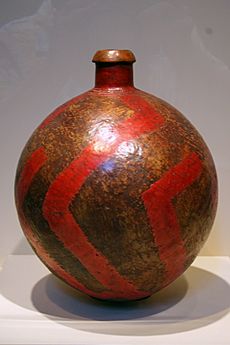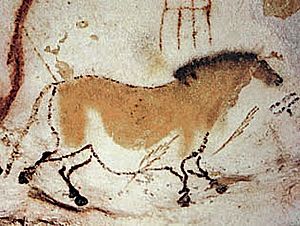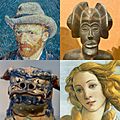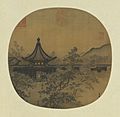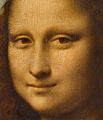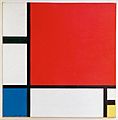Art facts for kids
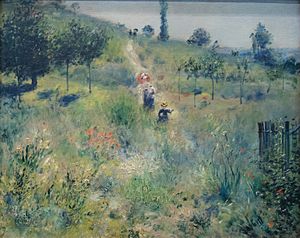
Art is a creative activity by people. The artist hopes that it affects the emotions of people who experience it. Artists express themselves by their art. Some people find art relaxing.
Many people disagree on how to define art. Some say people are driven to make art due to their inner creativity.
Art includes drawing, painting, sculpting, photography, performance art, dance, music, poetry, prose and theatre.
Contents
Types of art
Art is divided into the plastic arts, where something is made, and the performing arts, where something is done by humans in action. The other division is between pure arts, done for themselves, and practical arts, done for a practical purpose, but with artistic content.
- Plastic arts
- Performing arts
- Practical arts
- Culinary art (expression by making flavors and tastes): cooking
- The practical arts (expression by making things and structures: architecture, filming, fashion, photography, video games)
What "art" means
Some people say that art is a product or item that is made with the intention of stimulating the human senses as well as the human mind, spirit and soul.
An artwork is normally judged by how much impact it has on people, the amount of people who can relate to it, and how much people appreciate it.
The first and broadest sense of "art" means "arrangement" or "to arrange." In this sense, art is created when someone arranges things found in the world into a new or different design or form; or when someone arranges colors next to each other in a painting to make an image or just to make a pretty or interesting design.
Art can also be a form of expression of emotion. The artist may feel a certain emotion and feel that there is no way to express it other than to create something that means something to them. Most of the art created in this case is made for the artist rather than an audience. However, if an audience is able to connect with the emotion as well, then the art work may become publicly successful.
History of art
There are sculptures, cave painting and rock art dating from the Upper Paleolithic era.
All of the great ancient civilizations, such as Ancient Egypt, India, China, Greece, Rome or Arabia had works and styles of art. In the Middle Ages, most of the art in Europe showed people from the Bible in paintings, stained glass windows, and mosaic tile floors and walls.
Islamic art includes geometric patterns, Islamic calligraphy, and architecture. In India and Tibet, painted sculptures, dance, and religious painting were done. In China, arts included jade carving, bronzework, pottery, poetry, calligraphy, music, painting, drama, and fiction. There are many Chinese artistic styles, which are usually named after the ruling dynasty.
In Europe, after the Middle Ages, there was a "Renaissance" which means "rebirth". People rediscovered science and artists were allowed to paint subjects other than religious subjects. People like Michelangelo and Leonardo da Vinci still painted religious pictures, but they also now could paint mythological pictures too. These artists also invented perspective where things in the distance look smaller than things close up in the picture. This was new because in the Middle Ages people would paint all the figures close up and just overlapping each other.
In the late 1800s, artists in Europe, responding to Modernity created many new painting styles such as Classicism, Romanticism, Realism, and Impressionism. The history of twentieth century art includes Expressionism, Fauvism, Cubism, Dadaism, Surrealism, and Minimalism.
Roles of art
In some societies, people think that art belongs to the person who made it, such as Indigenous Aboriginal Australian Art. They think that the artist put his or her "talent" into the art. In this view, the art is the property of the artist.
In other societies, people think that art belongs to no one. They think that society has put its social capital into the artist and the artist's work. In this view, society is a collective that has made the art, through the artist.
Functions of art
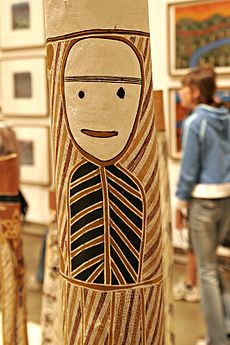
The functions of art include:
1) Cognitive function
- Works of art let us know about what the author knew, and about what the surrounding of the author were like.
2) Aesthetic function
- Works of art are more or less harmonic and bring pleasure, a sensation of beauty.
3) Prognostic function
- Some artists draw what they see the future like, and some of them are right, but most are not...
4) Recreation function
- Art makes us think about it, not about reality; we have a rest.
5) Value function
- What did the artist value? What aims did he like/dislike in human activity? This usually is clearly seen in artists' works.
6) Didactic function
- What message, criticism or political change did the artist wish to achieve?
Related pages
Images for kids
-
Clockwise from upper left: an 1887 self-portrait by Vincent van Gogh; a female ancestor figure by a Chokwe artist; detail from The Birth of Venus (c. 1484–1486) by Sandro Botticelli; and an Okinawan Shisa lion
-
Back of a Renaissance oval basin or dish, in the Metropolitan Museum of Art
-
The stylized signature of Sultan Mahmud II of the Ottoman Empire was written in Islamic calligraphy. It reads "Mahmud Khan son of Abdulhamid is forever victorious".
-
The Great Mosque of Kairouan in Tunisia, also called the Mosque of Uqba, is one of the finest, most significant and best preserved artistic and architectural examples of early great mosques. Dated in its present state from the 9th century, it is the ancestor and model of all the mosques in the western Islamic lands.
-
Painting by Song dynasty artist Ma Lin, circa 1250. 24.8 × 25.2 cm
-
Napoleon I on his Imperial Throne by Ingres (French, 1806), oil on canvas
-
Detail of Leonardo da Vinci's Mona Lisa, c. 1503–1506, showing the painting technique of sfumato
-
A Navajo rug made circa 1880
-
Mozarabic Beatus miniature. Spain, late 10th century
-
The Metropolitan Museum of Art in Manhattan. Museums are important forums for the display of visual art.
-
The Museum of Art in Basel (Switzerland), is the oldest public museum of art in the world.
-
Composition with Red Blue and Yellow (1930) by Piet Mondrian (Dutch, 1872–1944)
See also
 In Spanish: Arte para niños
In Spanish: Arte para niños


